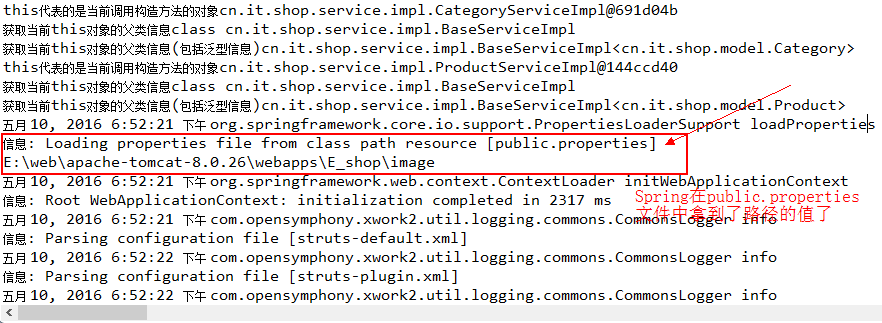本文共 3648 字,大约阅读时间需要 12 分钟。
版权声明:尊重博主原创文章,转载请注明出处哦~http://blog.csdn.net/eson_15/article/details/51365707
目录
在项目中如果有些参数经常需要修改,或者后期可能需要修改,那我们最好把这些参数放到properties文件中,源代码中读取properties里面的配置,这样后期只需要改动properties文件即可,不需要修改源代码,这样更加方便。在中也可以这么做,而且Spring有两种加载properties文件的方式:基于xml方式和基于注解方式。下面分别讨论下这两种方式。
1. 通过xml方式加载properties文件
我们以Spring实例化dataSource为例,我们一般会在beans.xml文件中进行如下配置:
- <!-- com.mchange.v2.c3p0.ComboPooledDataSource类在c3p0-0.9.5.1.jar包的com.mchange.v2.c3p0包中 -->
- <bean id="dataSource" class="com.mchange.v2.c3p0.ComboPooledDataSource">
- <property name="driverClass" value="com.mysql.jdbc.Driver" />
- <property name="jdbcUrl" value="jdbc:mysql://localhost:3306/shop" />
- <property name="user" value="root" />
- <property name="password" value="root" />
- </bean>
Spring中有个<context:property-placeholder location=""/>标签,可以用来加载properties配置文件,location是配置文件的路径,我们现在在工程目录的src下新建一个conn.properties文件,里面写上上面dataSource的配置:
- dataSource=com.mchange.v2.c3p0.ComboPooledDataSource
- driverClass=com.mysql.jdbc.Driver
- jdbcUrl=jdbc\:mysql\://localhost\:3306/shop
- user=root
- password=root
- <context:property-placeholder location="classpath:conn.properties"/><!-- 加载配置文件 -->
- <!-- com.mchange.v2.c3p0.ComboPooledDataSource类在c3p0-0.9.5.1.jar包的com.mchange.v2.c3p0包中 -->
- <bean id="dataSource" class="${dataSource}"> <!-- 这些配置Spring在启动时会去conn.properties中找 -->
- <property name="driverClass" value="${driverClass}" />
- <property name="jdbcUrl" value="${jdbcUrl}" />
- <property name="user" value="${user}" />
- <property name="password" value="${password}" />
- </bean>
- <!-- 与上面的配置等价,下面的更容易理解 -->
- <bean class="org.springframework.beans.factory.config.PropertyPlaceholderConfigurer">
- <property name="locations"> <!-- PropertyPlaceholderConfigurer类中有个locations属性,接收的是一个数组,即我们可以在下面配好多个properties文件 -->
- <array>
- <value>classpath:conn.properties</value>
- </array>
- </property>
- </bean>
2. 通过注解方式加载properties文件
还有一种就是通过注解的方式,在代码中使用@Value注解来加载配置文件中的值。
我们来看一个例子:假如我们要在程序中获取某个文件的绝对路径,我们很自然会想到不能在程序中写死,那么我们也可以卸载properties文件中。还是在src目录下新建一个public.properties文件,假设里面写了一条记录:
- filePath=E\:\\web\\apache-tomcat-8.0.26\\webapps\\E_shop\\image
- <!-- 第二种方式是使用注解的方式注入,主要用在java代码中使用注解注入properties文件中相应的value值 -->
- <bean id="prop" class="org.springframework.beans.factory.config.PropertiesFactoryBean">
- <property name="locations"><!-- 这里是PropertiesFactoryBean类,它也有个locations属性,也是接收一个数组,跟上面一样
- <array>
- <value>classpath:public.properties</value>
- </array>
- </property>
- </bean>
- @Component("fileUpload")
- public class FileUploadUtil implements FileUpload {
- private String filePath;
- @Value("#{prop.filePath}")
- //@Value表示去beans.xml文件中找id="prop"的bean,它是通过注解的方式读取properties配置文件的,然后去相应的配置文件中读取key=filePath的对应的value值
- public void setFilePath(String filePath) {
- System.out.println(filePath);
- this.filePath = filePath;
- }
以上就是Spring加载properties配置文件的两种方式。实际上,上面基于xml方式中的PropertyPlaceholderConfigurer类和这里基于注解方式的PropertiesFactoryBean类都是继承PropertiesLoaderSupport,都是用来加载properties配置文件的。
如有错误之处,欢迎留言指正~
_____________________________________________________________________________________________________________________________________________________
-----乐于分享,共同进步!
-----更多文章请看: